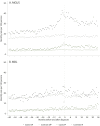Health impact of monoclonal gammopathy of undetermined significance (MGUS) and monoclonal B-cell lymphocytosis (MBL): findings from a UK population-based cohort
- PMID: 33619185
- PMCID: PMC7903106
- DOI: 10.1136/bmjopen-2020-041296
Health impact of monoclonal gammopathy of undetermined significance (MGUS) and monoclonal B-cell lymphocytosis (MBL): findings from a UK population-based cohort
Erratum in
-
Correction: Health impact of monoclonal gammopathy of undetermined significance (MGUS) and monoclonal B-cell lymphocytosis (MBL): findings from a UK population-based cohort.BMJ Open. 2022 Jul 6;12(7):e041296corr1. doi: 10.1136/bmjopen-2020-041296corr1. BMJ Open. 2022. PMID: 35793926 Free PMC article. No abstract available.
Abstract
Objective: To examine mortality and morbidity patterns before and after premalignancy diagnosis in individuals with monoclonal gammopathy of undetermined significance (MGUS) and monoclonal B-cell lymphocytosis (MBL) and compare their secondary healthcare activity to that of the general population.
Design: Population-based patient cohort, within which each patient is matched at diagnosis to 10 age-matched and sex-matched individuals from the general population. Both cohorts are linked to nationwide information on deaths, cancer registrations and Hospital Episode Statistics.
Setting: The UK's Haematological Malignancy Research Network, which has a catchment population of around 4 million served by 14 hospitals and a central diagnostic laboratory.
Participants: All patients newly diagnosed during 2009-2015 with MGUS (n=2193) or MBL (n=561) and their age and sex-matched comparators (n=27 538).
Main outcome measures: Mortality and hospital inpatient and outpatient activity in the 5 years before and 3 years after diagnosis.
Results: Individuals with MGUS experienced excess morbidity in the 5 years before diagnosis and excess mortality and morbidity in the 3 years after diagnosis. Increased rate ratios (RRs) were evident for nearly all clinical specialties, the largest, both before and after diagnosis, being for nephrology (before RR=4.29, 95% CI 3.90 to 4.71; after RR=13.8, 95% CI 12.8 to 15.0) and rheumatology (before RR=3.40, 95% CI 3.18 to 3.63; after RR=5.44, 95% CI 5.08 to 5.83). Strong effects were also evident for endocrinology, neurology, dermatology and respiratory medicine. Conversely, only marginal increases in mortality and morbidity were evident for MBL.
Conclusions: MGUS and MBL are generally considered to be relatively benign, since most individuals with monoclonal immunoglobulins never develop a B-cell malignancy or any other monoclonal protein-related organ/tissue-related disorder. Nonetheless, our findings offer strong support for the view that in some individuals, monoclonal gammopathy has the potential to cause systemic disease resulting in wide-ranging organ/tissue damage and excess mortality.
Keywords: epidemiology; leukaemia; lymphoma; myeloma; public health.
© Author(s) (or their employer(s)) 2021. Re-use permitted under CC BY. Published by BMJ.
Conflict of interest statement
Competing interests: None declared.
Figures



Similar articles
-
Hospital population screening reveals overrepresentation of CD5(-) monoclonal B-cell lymphocytosis and monoclonal gammopathy of undetermined significance of IgM type.Ann Hematol. 2015 Sep;94(9):1559-65. doi: 10.1007/s00277-015-2409-9. Epub 2015 Jun 5. Ann Hematol. 2015. PMID: 26040471 Clinical Trial.
-
Monoclonal Gammopathy of Undetermined Significance After Kidney Transplantation: Single-Center Experience.Transplantation. 2017 Nov;101(11):e337-e342. doi: 10.1097/TP.0000000000001884. Transplantation. 2017. PMID: 28731904
-
[Monoclonal gammopathy of undetermined significance and monoclonal B-lymphocytosis].Internist (Berl). 2013 Jun;54(6):709-14. doi: 10.1007/s00108-012-3215-2. Internist (Berl). 2013. PMID: 23670732 German.
-
Does my patient with a serum monoclonal spike have multiple myeloma?Hematol Oncol Clin North Am. 2012 Apr;26(2):383-93, ix. doi: 10.1016/j.hoc.2012.02.009. Hematol Oncol Clin North Am. 2012. PMID: 22463833 Free PMC article. Review.
-
Prevalence, clinical aspects, and natural history of IgM MGUS.Cytometry B Clin Cytom. 2010;78 Suppl 1(Suppl 1):S91-7. doi: 10.1002/cyto.b.20550. Cytometry B Clin Cytom. 2010. PMID: 20839342 Free PMC article. Review.
Cited by
-
Cohort Profile Update: The Haematological Malignancy Research Network (HMRN) UK population-based cohorts.Int J Epidemiol. 2022 Jun 13;51(3):e87-e94. doi: 10.1093/ije/dyab275. Int J Epidemiol. 2022. PMID: 35134983 Free PMC article. No abstract available.
-
CHIPing Away at Proteomics to Find Correlations with Myeloid Neoplasms.Clin Cancer Res. 2024 Aug 1;30(15):3095-3097. doi: 10.1158/1078-0432.CCR-24-0827. Clin Cancer Res. 2024. PMID: 38819216 Free PMC article.
-
Excess morbidity and mortality among survivors of childhood acute lymphoblastic leukaemia: 25 years of follow-up from the United Kingdom Childhood Cancer Study (UKCCS) population-based matched cohort.BMJ Open. 2022 Mar 7;12(3):e056216. doi: 10.1136/bmjopen-2021-056216. BMJ Open. 2022. PMID: 35256445 Free PMC article.
-
Treatment of Patients with Monoclonal Gammopathy of Clinical Significance.Cancers (Basel). 2021 Oct 13;13(20):5131. doi: 10.3390/cancers13205131. Cancers (Basel). 2021. PMID: 34680279 Free PMC article. Review.
-
Monoclonal gammopathy of increasing significance: time to screen?Haematologica. 2023 Jun 1;108(6):1476-1486. doi: 10.3324/haematol.2022.281802. Haematologica. 2023. PMID: 36373250 Free PMC article. Review.
References
Publication types
MeSH terms
Grants and funding
LinkOut - more resources
Full Text Sources
Other Literature Sources
Medical
Miscellaneous
